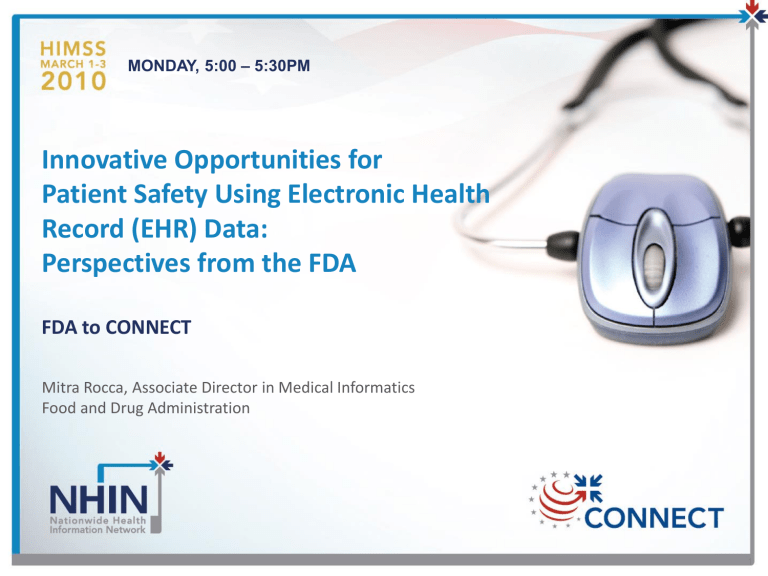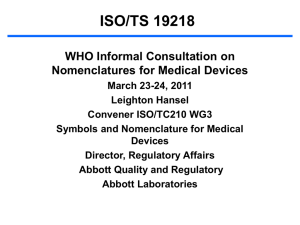Innovative Opportunities for Patient Safety Using Electronic Health

MONDAY, 5:00
– 5:30PM
Innovative Opportunities for
Patient Safety Using Electronic Health
Record (EHR) Data:
Perspectives from the FDA
FDA to CONNECT
Mitra Rocca, Associate Director in Medical Informatics
Food and Drug Administration
1
The Food and Drug Administration (FDA)
The FDA is responsible for protecting the public health by assuring the safety, efficacy, and security of human and veterinary drugs, biological products, medical devices, our nation’s food supply, cosmetics, and products that emit radiation.
HIMSS 2010 2
The FDA as a Public Health Agency
Margaret A. Hamburg, M.D., and Joshua M. Sharfstein, M.D.
“…The FDA’s job is to minimize risks through education, regulation, and enforcement. To be credible in all these tasks, the agency must communicate frequently and clearly about risks and benefits — and about what organizations and individuals can do to minimize risk ….”
NEJM, June 11, 2009
HIMSS 2010 3
Some Initiatives Focusing on Improving Drug Safety
HIMSS 2010
Sentinel OMOP MedWatch Spontaneous
Adverse Event
Reporting via
EHRs
4
Example 1:
FDA Initiative Aiming at Improving Drug Safety
Sentinel: Develop an active surveillance system
•
Goals:
Strengthen FDA's ability to monitor post-market performance of medical products
– Active surveillance may identify an increased risk of common adverse events (e.g., MI, fracture) that health care providers may not suspect are related to medical products
– Safety issues may be identified and evaluated in near real-time
• Augment, not replace, existing safety monitoring systems
• Enable FDA to access existing automated healthcare data by partnering with data holders (e.g., health plans, owners of electronic health records, others)
HIMSS 2010 5
Example 2:
Public-Private Initiative Aiming at Improving Drug Safety
Observational Medical Outcomes Partnership (OMOP): A public-private partnership to serve the public health by testing whether multi-source observational data can improve our ability to assess drug safety and benefits
Goals:
• Assess the appropriate technology and data infrastructure required for systematic monitoring of observational data
• Develop and test the feasibility and performance of the analysis methods
• Evaluate required governance structures
HIMSS 2010 6
Example 3:
Initiatives Aiming at Improving Device Safety Post-Market
Electronic Submission
Goal: Promote and protect the health of the public by ensuring the safety and effectiveness of medical devices and the safety of radiological products
Initiatives at Center for Devices and Radiological Health (CDRH):
• Unique Device Identifier
• Electronic Medical Device Reporting (eMDR)
• MedSun – web-based reporting from trained Hospitals
• Event Problem Codes – standard vocabulary for capturing device problems
HIMSS 2010 7
MedWatch: The FDA Adverse Event Reporting Program
Overview
Background: 1993 - MedWatch, announced by Commissioner David Kessler
Spontaneous voluntary reporting
Benefits:
• Make it easier for providers to identify and report adverse events
• Increase physician understanding and awareness of drug induced diseases
• More widely disseminate safety information on the
FDA’s actions that have resulted from adverse event and product problem reporting
HIMSS 2010 8
Current Process in Adverse Event Reporting:
Healthcare Provider’s Perspective
Challenges: Inconvenient to healthcare providers
Issues:
• Interrupts healthcare provider’s workflow
The 30 second rule [C. McDonald]
• Requires multiple entry of data from various sources into free text and structured fields
• Not clear what data required/requested
• Not clear how or where to submit report
• Lack of knowledge and training
HIMSS 2010 9
FDA Use Case: Reporting of Spontaneous Adverse
Event Reporting to FDA via EHR Systems
Problem to be Studied: Reporting adverse events interrupts the routine of providing care and imposes a burden on health care providers – greatly decreasing the probability that events will be reported to FDA and medical product manufacturers
Use Case Description:
Spontaneous Adverse Event Reporting via EHR Systems
• Data collection incorporated at point of care
• Very light footprint for EHR
• Portable to other EHR systems
• Can take advantage of further developments in automated recognition
• Global solution
• Coordinated Use of Industry standards (ISO/HL7 Individual Case Safety Report (ICSR),
Continuity of Care Document (CCD), IHE Retrieve Form for Data Capture (RFD)
HIMSS 2010 10
Adverse Event Reporting Information Flow
(Brigham and Women’s Hospital)
Physician discontinues drug due to Adverse
Event (AE)
EHR System creates XML data file
EHR System sends XML data file via
RFD
Physician completes and submits AE form
XML data file is received and pre-populates
AE form
AE form is displayed to physician
AE Form data is stored in AE repository as an AE report
Receive message via CONNECT
Transmit message to FDA via CONNECT
Create an
ICSR message
Adverse event message is displayed
(MedWatch form)
AE report data coded
(MedDRA)
Set serious flag (Y/N)
11 HIMSS 2010
Adverse Event Reporting Information Flow
Physician discontinues drug due to Adverse
Event (AE)
EHR System creates XML data file
EHR System sends XML data file via RFD
Physician completes and submits AE form
XML data file is received and pre-populates
AE form
AE form is displayed to physician
Transmit message to FDA via CONNECT
Receive message via CONNECT
Adverse event message is displayed
(MedWatch form)
AE Form data is stored in AE repository as an
AE report
Create an
ICSR message
AE report data coded
(MedDRA)
Set serious flag (Y/N)
HIMSS 2010 12
Thank You
The participation of any company or organization in the NHIN and CONNECT area within the HIMSS Interoperability showcase does not represent an endorsement by the Office of the National Coordinator for Health Information Technology, the Federal
Health Architecture or the Department of Health and Human Services.
13
Backup Slides
14
The Nationwide Health Information Network
HIMSS 2010 15
Unique Device Identification
Current State:
• All in supply chain add their own id number/catalogue number to a product
• Information on device use difficult to capture in EHR
• No unique number
HIMSS 2010 16
Unique Device Identification
Future:
• UDI added to EHR to documenting medical device use in patient’s EHR/PHR, hospital information systems, claims data
• Improve AE Reporting
• Improve FDA’s ability to query data systems for relevant device information – Sentinel
HIMSS 2010 17
Electronic Medical Device Reporting (eMDR)
• Initiated in 2005
• First Report received in 2007
• Notice of Propose Rule Making published late 2009
• Total of 48 Device Firms Report this way
• Submissions can be sent via FDA Gateway or through Data Entry
– Uses HL7 v3 r1 as data exchange method
– Vocabulary used in message is stored in NCI Thesaurus
HIMSS 2010 18
Medical Product Safety Network MedSun
• Response to Device Adverse Event Reporting Requirement for User
Facilities (Voluntary for Drugs)
– 2002 – First Reports
– 350+ Network of User Facilities
• Feedback and Training
– Sites specifically trained in medical product adverse event reporting
– Feedback and User Groups
• On-line Reporting
– FDA builds relationship with Clinicians, Safety Officers, Risk managers and other Designated Reporters
HIMSS 2010 19
Who are the Stakeholders with Interest in Adverse
Event Reporting?
Goal of Capturing and Reporting Adverse Events: Managing the risks of medical product use
Stakeholders:
• Patients/Consumers
• Healthcare providers and their organizations who wish to identify best use of drugs/devices to avoid care decisions
• Industry that has regulatory responsibility to manage safety of their marketed products
• FDA as a public health agency responsible for risk/safety communication
HIMSS 2010 20







